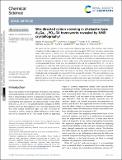Files in this item
Site-directed cation ordering in chabazite-type AlxGa1–xPO4-34 frameworks revealed by NMR crystallography
Item metadata
| dc.contributor.author | Dawson, Daniel M. | |
| dc.contributor.author | Clayton, Jasmine | |
| dc.contributor.author | Marshall, Thomas | |
| dc.contributor.author | Guillou, Nathalie | |
| dc.contributor.author | Walton, Richard | |
| dc.contributor.author | Ashbrook, Sharon E. | |
| dc.date.accessioned | 2024-02-29T09:30:04Z | |
| dc.date.available | 2024-02-29T09:30:04Z | |
| dc.date.issued | 2024-03-28 | |
| dc.identifier | 298462590 | |
| dc.identifier | 98ffeec9-2531-4715-9ff0-2b16544456f4 | |
| dc.identifier | 85186073736 | |
| dc.identifier.citation | Dawson , D M , Clayton , J , Marshall , T , Guillou , N , Walton , R & Ashbrook , S E 2024 , ' Site-directed cation ordering in chabazite-type Al x Ga 1–x PO 4 -34 frameworks revealed by NMR crystallography ' , Chemical Science , vol. 15 , no. 12 , pp. 4374-4385 . https://doi.org/10.1039/D3SC06924A | en |
| dc.identifier.issn | 2041-6520 | |
| dc.identifier.other | ORCID: /0000-0002-4538-6782/work/153977369 | |
| dc.identifier.other | ORCID: /0000-0002-8110-4535/work/153977846 | |
| dc.identifier.uri | https://hdl.handle.net/10023/29383 | |
| dc.description | The UK High-Field Solid-State NMR Facility used in this research was funded by EPSRC and BBSRC (EP/T015063/1), as well as the University of Warwick including via part funding through Birmingham Science City Advanced Materials Projects 1 and 2 supported by Advantage West Midlands (AWM) and the European Regional Development Fund (ERDF). Collaborative assistance from the Facility Manager Team (Dinu Iuga, University of Warwick) is acknowledged. We acknowledge support from the Collaborative Computational Project on NMR Crystallography CCP-NC funded by EPSRC (EP/T026642/1) and the UKCP consortium funded by EPSRC (EP/K013564/1). Some of the equipment used in this work was provided by the University of Warwick’s Research Technology Platforms. Access to I11 at Diamond Light Source was provided by the Block Allocation Group award “Oxford/Warwick Solid State Chemistry BAG to probe composition−structure−property relationships in solids” (CY25166). In order to meet institutional and research funder open access requirements, any accepted manuscript arising shall be open access under a Creative Commons Attribution (CC-BY) reuse licence with zero embargo. The research data supporting this publication can be accessed in Ref. 53. | en |
| dc.description.abstract | We report the first synthesis of the mixed-metal chabazite-type AlxGa1–xPO4-34(mim) solid solution, containing 1- methylimidazolium, mim, as structure directing agent (SDA), from the parent mixed-metal oxide solid solution, γ-(AlxGa1– x)2O3. This hitherto unreported family of materials exhibits complex disorder, arising from the possible distributions of cations over available sites, the orientation of the SDA and the presence of variable amounts of water, which provides a prototype for understanding structural subtleties in nanoporous materials. In the as-made forms of the phosphate frameworks, there are three crystallographically distinct metal sites: two tetrahedral MO4 and one octahedral MO4F2 (M = Al, Ga). A combination of solid-state NMR spectroscopy and periodic DFT calculations reveal that the octahedral site is preferentially occupied by Al and the tetrahedral sites by Ga, leading to a non-random distribution of cations within the framework. Upon calcination to the AlxGa1–xPO4-34 framework, all metal sites are tetrahedral and crystallographically equivalent in the average R3 symmetry. The cation distribution was explored by 31P solid-state NMR spectroscopy, and it is shown that the non-random distribution demonstrated to exist in the as-made materials would be expected to give remarkably similar patterns of peak intensities to a random distribution owing to the change in average symmetry in the calcined materials. | |
| dc.format.extent | 12 | |
| dc.format.extent | 1648046 | |
| dc.language.iso | eng | |
| dc.relation.ispartof | Chemical Science | en |
| dc.subject | QD Chemistry | en |
| dc.subject | DAS | en |
| dc.subject.lcc | QD | en |
| dc.title | Site-directed cation ordering in chabazite-type AlxGa1–xPO4-34 frameworks revealed by NMR crystallography | en |
| dc.type | Journal article | en |
| dc.contributor.sponsor | EPSRC | en |
| dc.contributor.sponsor | EPSRC | en |
| dc.contributor.institution | University of St Andrews. EaSTCHEM | en |
| dc.contributor.institution | University of St Andrews. School of Chemistry | en |
| dc.identifier.doi | https://doi.org/10.1039/D3SC06924A | |
| dc.description.status | Peer reviewed | en |
| dc.identifier.grantnumber | EP/T026642/1 | en |
| dc.identifier.grantnumber | EP/T014350/1 | en |
This item appears in the following Collection(s)
Items in the St Andrews Research Repository are protected by copyright, with all rights reserved, unless otherwise indicated.

